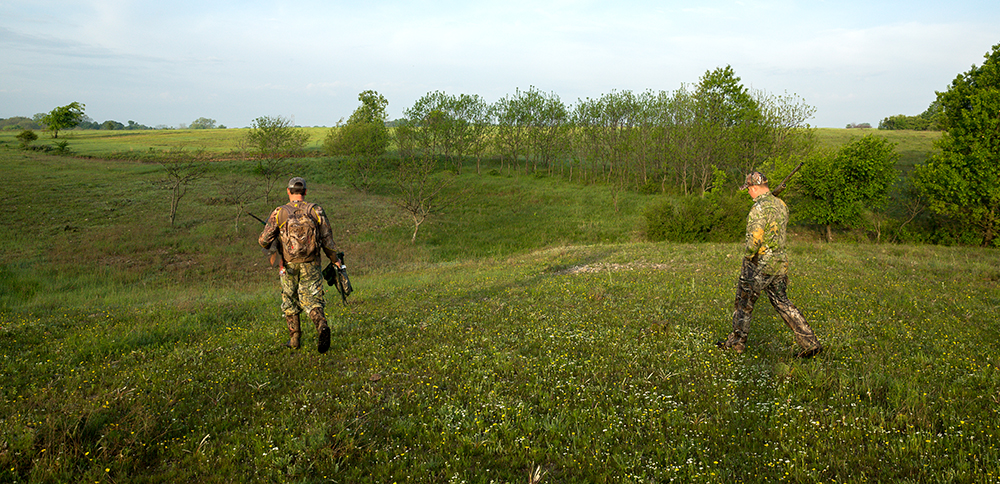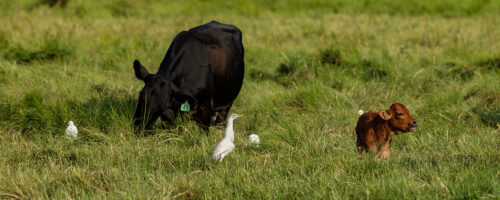Do what you can for wild turkey habitat with your ranch management choices
Regenerative ranching and grazing practices promote the plant diversity wild turkeys need to thrive on your land. As populations decline, they need our help.
For the majority of the last 50 years, wild turkeys served as a great North American comeback story. Populations went from nearly non-existent to covering every part of the contiguous United States. Until recently.
“Turkeys were the great success story for wildlife departments all across the nation,” says Josh Gaskamp, Noble Research Institute regenerative ranching advisor and manager. But today, many wild turkey populations, particularly those in the Southern Great Plains, are in steep decline. The “why” is unclear, but theories include loss of habitat, disease and climate events – both drought and excessive rain.
Kansas, Oklahoma, and Nebraska – states that boasted big turkey numbers and the associated recreational opportunities over the past several decades – have seen wild-turkey populations declining up to 50% in the past 15 years, according to state wildlife agencies. As these population numbers drop, so have hunting bag limits, tag numbers and even hunting seasons. Kansas canceled its 2023 fall season after its wild turkey population hit a 15-year low.
Researchers in these states and others have launched studies into why turkey production has taken such a dive. A joint study by Oklahoma State University and Texas A&M seeks a comprehensive understanding of the turkeys’ nesting behavior, reproductive success and survival of different life stages to determine if a decline is occurring.

What ranchers and landowners can do
There are ways ranchers and landowners can work to enhance turkey habitat in order to develop or improve a hunting enterprise while at the same time pursuing their regenerative ranching goals.
“They are an economic driver,” Gaskamp says of wild turkeys, “not just for the value of a hunting or recreational enterprise, but also in increasing the overall value of your land.”
Fortunately, wild turkeys are generalists when it comes to habitat requirements. There’s not one specific type of environment they need to survive, he says, but there are specific requirements they have at different life stages.

Three habitat requirements for wild turkeys
Ranchers who want to increase their turkey habitat can focus on providing the three key requirements wild turkeys need to succeed:
1. Trees with clear understories for roosting. The ideal roost trees are 40-50-feet tall, have open crowns and plenty of horizontal limbs. Almost as important as the trees turkeys need to roost is the state of the tree’s understory. Turkeys want to be able to see clear ground, free of predators, when they are ready to leave the roost.
“They can’t roost in areas that are overgrown with brush and cedar, especially in areas taken over by eastern red cedar, because they can’t see the forest floor,” Gaskamp says. “They want to fly down and land on clear ground in the morning.”
2. Ground cover in which to nest. For nesting habitat, the birds need enough cover to hide and protect the next generation. The biggest threats to wild turkeys are mid-level predators like racoons or skunks that plunder eggs out of the nest.
“We can help mitigate that by creating good habitat for those nests,” namely diverse native grasslands, Gaskamp says. “Bermudagrass monocultures – or any monoculture, really – are just not going to provide the kind of cover birds need to nest in.”
3. Diversity for food, shelter. Wild turkeys – and most ground-nesting birds that indicate the presence of healthy grassland ecosystems – need landscape diversity to thrive, Gaskamp says. That should be encouraging to ranchers who are aiming for regenerative management.
“If a rancher is truly managing regeneratively, and they’re providing adequate rest and recovery for their grasses, they’re creating a mosaic pattern of management on the ranch,” he says. “They’re grazing in a way that allows full recovery, so the landscape is dotted with late-successional plants here, early successional plants there, moderate-succession over here.”

Four management tips to improve turkey habitat
If a regenerative ranch management approach that is good for both livestock grazing and gobblers is your goal, keep these management tips in mind.
1. Diversity demands disturbance. One of the primary ways to increase the diversity that wildlife and healthy soils need to thrive is controlled disturbances. Intentional disturbance followed by adequate rest and recovery creates opportunities for cool- and warm-season annual plants to fill the mosaic of successional stages.
“Disturbance – events like grazing, but not overgrazing; fire, but not all at once – reverts land to earlier successional states, which allows for forbs to come in,” Gaskamp says. “Forbs have flowers, which attracts insects like caterpillars and grasshoppers. That’s what young poults need to eat until they mature and shift their diets to more grain.”
2. Don’t forget your riparian areas. Historically, many conservation-minded ranchers and land managers have received the message that water-rich riparian areas are a ‘do-not-disturb’ zone. This hands-off approach can lead to a thick, unruly understory that may do more harm than good. Rather, Gaskamp suggests aiming for targeted management to enhance habitat on riparian areas while also increasing land utilization and efficiency.
“We need to create disturbances in those riparian areas, but they don’t need to be intense disturbances,” he says. “They need to be short-duration grazes to help limit the brush encroachment and clear out that understory.”
That has the triple-benefit of boosting bird-roosting habitat, creating healthier waterways and increasing land utilization for livestock.
3. Consider your impact on predator/prey relationships. Every action creates a cascading effect, so if you want a healthier, more robust turkey population, look beyond the birds themselves.
On a pathway to more regenerative management, many ranchers look to reduce inputs and put their management more in tune with natural remedies, both to save expenses and boost soil health. Another benefit to fewer chemical inputs may be more robust wildlife populations.
“A lot of those pesticides kill the insects the turkeys need to feed on, and the herbicides kill the forbs those insects need to exist there,” Gaskamp says. “And then we work really hard to eliminate apex predators like coyotes or wolves, while less people are trapping those smaller, fur-bearing predators these days. That leaves those mid-level predator populations unchecked.”
The right management balance in these areas is unique to every ranch and situation, so he simply suggests being more cognizant of the cascading impact of every decision.
4. Know what’s in your control, and what’s only moderately in your control. The two primary drivers of wild turkey populations come down to habitat and weather.
“As managers, we can really only have a strong influence on one of those,” Gaskamp says, but don’t underestimate your habitat’s ability to create resiliency in the face of uncontrollable weather.
Extreme drought can damage wildlife populations, but management that aims at increasing soil health also builds more resilient grasslands with deeper roots and more water holding capacity. That helps on the inverse of extreme weather, too.
“What we’ve seen more of in the past few years is poor nesting success because of heavy rain in early spring. If our soil isn’t in good shape, it’s not infiltrating water, and those nests are sitting in puddles that should be absorbed by the soil. The eggs can’t survive underwater.”
That’s why, Gaskamp says, ground-nesting birds of all species – wild turkeys, quail, pheasants, prairie chickens and more – are known symbols of healthy grassland ecosystems.
“If these birds are present on your ranch, it’s a signature of your good grassland management,” he says.



Comment